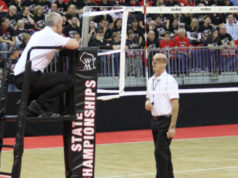Officials often wonder what higher-level officials are thinking between points while up on the referee stand.
What is going through the minds of officials as they prepare for the next play?
Let’s take a look at the job responsibilities of a first referee between the time a point is awarded and the beckoning for the next serve.
Watch for any unsportsmanlike actions
The majority of points in a volleyball match are not controversial. Examples include a ball that falls to the floor as a down ball or the ball sailing out of bounds. These plays could have controversy, but the majority of the time, these are easy calls and all individuals in the gym agree with the decision of the first referee.
However, there are several plays in which unsportsmanlike behavior might follow. Examples include a big block or hit by the middle where a player might stare down an opponent, a play where a coach or player believes an official missed a touch, or a close line or ballhandling call that went against their team. After awarding the point, the first referee needs to observe players and coaches for unsportsmanlike actions toward the other team or the officials. The first referee may need to provide a verbal warning or use cards to handle the situation.
Scan the benches for substitutes or timeouts
After awarding the point and observing the general behavior of the teams, the first referee should conduct a visual scan of each team’s bench. The first part of the scan is observing the benches for any substitution or timeout requests. Of course, the second referee is usually the one who initiates this, but it is important the first referee scans as well in case the second referee is pre-occupied (such as answering a coach’s question or talking to the scorer’s table) and misses the request. It is also a good time to observe the actions of the second referee and make sure you both are ready to begin the next play before beckoning for serve.
The scan for beckoning for serve
Starting with the receiving team, the first referee should scan the court. This scan should include looking at the line judges and players of the receiving team on both the court and the bench. The first referee needs to ensure all players are ready to play and are in the correct position.
After reviewing the receiving team, the first referee will quickly observe the scorer’s table and the second referee to make sure they are ready for play.
The last part is scanning the serving team. The first referee needs to confirm the server has the ball and take one last look at the second referee before beckoning for the serve.
These scans are important to identify any potential risks for injury, such as untied shoes, and to look for general alignment of players. The last look at the second referee will hopefully catch any last-minute substitutions or timeout requests.
Although scanning the whole court and both team benches may seem like it will take a long time, the process only takes a couple of seconds. As a first referee, strive to keep the pace of the players. Coaches can get frustrated when the server is ready to serve and the first referee is slow to beckon for service. The majority of the time, referees can conduct their scan and beckon for service without a delay.
During the scan, officials should make a mental note of the setter’s location and identify the back-row players. For officials who quickly learn the rotation, this process can happen smoothly.
However, early in a set or for officials who struggle to remember rotations, the scanning process can slow down. This is acceptable because it is important to identify player-court location before beckoning for serve so officials are not surprised with a position fault or back-row decision during a live ball.
When there is extra time
When there is a substitute or if the ball rolls a long way, the first referee has extra time between points. This is a good time to slow down the scan and observe any behaviors or situations that may need to be addressed immediately or more likely during a timeout or end of set.
Examples of these might include substitutes creeping too close to the playing court (when permitted to stand), items being on the playing area that may interfere or phones being out at the scorer’s table if not using certified scorers.
Mentally reset
Have you ever beckoned for serve still thinking about the last play? Doing this may provide the opportunity to miss something because your focus is elsewhere. It is important — as the first referee — to take an extra second or two to clear your head, if needed, before beckoning for the next serve. If there is extra time, like those moments mentioned earlier, it is helpful to practice mental health strategies like visualization techniques, relaxation breathing and positive self-talk.
Summary
When watching a high-level match, you may think the first referee is simply resting between points. You may not realize all the items the first referee is observing between points and the importance of scanning the court. Use these tips and strategies when you next take the stand to help elevate your game.
What's Your Call? Leave a Comment:
Note: This article is archival in nature. Rules, interpretations, mechanics, philosophies and other information may or may not be correct for the current year.
This article is the copyright of ©Referee Enterprises, Inc., and may not be republished in whole or in part online, in print or in any capacity without expressed written permission from Referee. The article is made available for educational use by individuals.


















